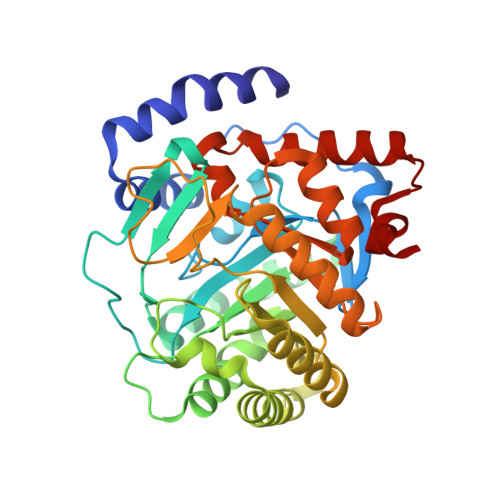Bifunctional Naphtho[2,3- d ][1,2,3]triazole-4,9-dione Compounds Exhibit Antitumor Effects In Vitro and In Vivo by Inhibiting Dihydroorotate Dehydrogenase and Inducing Reactive Oxygen Species Production.
Zuo, Z., Liu, X., Qian, X., Zeng, T., Sang, N., Liu, H., Zhou, Y., Tao, L., Zhou, X., Su, N., Yu, Y., Chen, Q., Luo, Y., Zhao, Y.(2020) J Med Chem 63: 7633-7652
- PubMed: 32496056
- DOI: https://doi.org/10.1021/acs.jmedchem.0c00512
- Primary Citation of Related Structures:
6JMD, 6JME, 6LP6, 6LP7, 6LP8 - PubMed Abstract:
Human dihydroorotate dehydrogenase ( h DHODH) is an attractive target for cancer therapy. Based on its crystal structure, we designed and synthesized a focused compound library containing the structural moiety of 1,4-benzoquinone, which possesses reactive oxygen species (ROS) induction capacity. Compound 3s with a naphtho[2,3- d ][1,2,3]triazole-4,9-dione scaffold exhibited inhibitory activity against h DHODH. Further optimization led to compounds 11k and 11l , which inhibited h DHODH activity with IC 50 values of 9 and 4.5 nM, respectively. Protein-ligand cocrystal structures clearly depicted hydrogen bond and hydrophobic interactions of 11k and 11l with h DHODH. Compounds 11k and 11l significantly inhibited leukemia cell and solid tumor cell proliferation and induced ROS production, mitochondrial dysfunction, apoptosis, and cell cycle arrest. Nanocrystallization of compound 11l displayed significant in vivo antitumor effects in the Raji xenograft model. Overall, this study provides a novel bifunctional compound 11l with h DHODH inhibition and ROS induction efficacy, which represents a promising anticancer lead worthy of further exploration.
- State Key Laboratory of Biotherapy and Cancer Center, West China Hospital, West China Medical School, Sichuan University, and Collaborative Innovation Center for Biotherapy, Chengdu 610041, China.
Organizational Affiliation:























